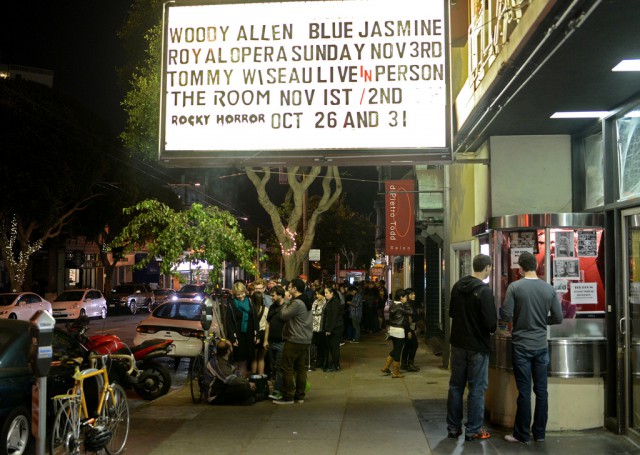
Written by Jake Montero
Photos by Virginia Tieman
When I arrive early he is already there.
I’m no longer struck by his unique appearance, probably because we’ve met before, but mostly because of the many hours I’ve spent watching him; incapable of averting my eyes, focused on his every move.
Yet there’s something different about him this time. As I look closer, the inconsistency becomes apparent. Last time he was wearing three belts.
Tonight he is wearing four.
The he in question, is Tommy Wiseau. A decade ago, Wiseau wrote, directed, produced and starred in The Room, a film considered by many to be the worst of all time.
The Room is screened monthly at San Francisco’s Clay Theater to raucous crowds, and with Wiseau in attendance for the films tenth anniversary, this evening is no different. The Room’s all-encompassing terribleness has generated a dedicated cult following all across the country, with nearly every major city holding semi-regular screenings of the legendary disasterpiece.
By traditional film standards, The Room breaks every rule with regards to good acting, storytelling, camerawork, dialogue, set decoration and general coherence. Some characters disappear halfway through the film, while others appear out of nowhere.
The Room’s only consistent storyline deals with the “future wife” (the word fiance is never used) of main character Johnny (played by Wiseau) engaging in an affair with his best friend, a younger and more handsome man named Mark, played by Greg Sestero. This relatively
straightforward plot is accented by a myriad of unexplained subplots, including a strange neighbor, Denny, who wants to watch Wiseau have sex, and multiple scenes where the characters all go outside to toss around a football like a hot potato.
However, it is these very eccentricities that make screenings of The Room an interactive audience experience second-to-none. You don’t go to the theater to quietly watch and analyze, you go to collectively make fun of some of the most inexplicable footage ever compiled by man.
The evening begins with a meet and greet in the lobby of the Clay, with the aforementioned Wiseau accompanied by Sestero. Wiseau looks like an aging rock star, with curly long black hair and terminator sunglasses that he insists on wearing indoors.
Pictures are taken and memorabilia is sold and signed; including Wiseau’s new line of boxer brief underwear, for anybody who desires to have “WISEAU” scrawled across their ass.
Because Wiseau and his film often seem too unbelievable to be real, meeting the man behind the madness is an experience that all true Room fans must have.
“He’s like a cartoon character,” says Brenden Page, a Broadcasting major at San Francisco State, who attended his first Room screening.
As the productions sole creative force, it’s impossible to talk about The Room without mentioning Wiseau. Before the film is shown, both Wiseau and Sestero get on stage, flanked by half naked fans in Wiseau undies, to engage in a Q&A with the audience. Wiseau is known for his often indecipherable answers to questions. When asked about the character Denny, Wiseau claims that he is “a little bit retarded.” Shortly after this however, he claims that Pacific Heights is also retarded, making it unclear as to whether or not he knows what that word means.
Once the film begins, it doesn’t take long for the audience to get involved. The opening credits feature random establishing shots of San Francisco, the film’s setting, nearly all of which include the Pacific Ocean. Everybody simultaneously yells “water!” when the ocean is shown, only to erupt in applause when Wiseau appears for the first time, riding a cable car as the lone passenger.
There are many established audience traditions, such as tossing footballs around when the characters do and slow clapping during the
films four extended sex scenes. The audience is required to be silent only once, during the infamous nineteen second flower shop scene, considered by most Room aficionados to be the finest the film has to offer (YouTube “the room flower shop”, you won’t be disappointed).
The throwing of plastic spoons is The Room’s most famous tradition. In Johnny’s house there are a handful of framed pictures of spoons. The pictures are never explained, nor are spoons present anywhere else in the film. Whenever a spoon picture is visible on the screen everybody in the audience is encouraged to throw as many plastic spoons in the air as possible while yelling “spoons”!
By the time the film is over, the theater floor is covered with hundreds of the plastic utensils.
“Tommy was trying to say something profound with The Room,” says co-star Greg Sestero. “I believe it is his most profound attempt at creative expression. The Room is Tommy and that’s what makes the movie such a unique experience, because no one sees the world the way Tommy does.”
Sestero recently released The Disaster Artist, a book detailing the production of The Room and how he came to know and work with Wiseau.
“From the moment I showed the rough cut of The Room to my family, I knew it was something special and it could captivate audiences in the strangest of ways if given the chance,” Sestero continues. “That being said, I never thought it would amass the international following it has now.”
The book sheds light on Tommy’s obsession with wearing multiple belts: “It keeps my ass up. Plus it feels good.” Fair enough.
The film concludes to riotous applause. Outside, Room first timers are in awe of what they’ve just experienced. Whether it’s your first or twentieth viewing, nobody ever leaves disappointed.
“It was a good experience and and it seemed like even the staff really enjoyed it.” says Page. “The guy at the concession stand left the door opened and was laughing his ass off. Its a really cool communal thing.”
The Room’s over the top absurdity, has led some to believe that the film is bad on purpose, and that Wiseau is pulling a fast one on all of us. Greg
Sestero claims this is not the case.
“Tommy believes The Room is the greatest movie ever made. He always has and always will believe that.”
With the amount of joy this so called terrible movie has brought, he might just be right. The Room is screened once a month at the Clay
Theater on Fillmore Street. X






Towing Management • Jun 4, 2016 at 10:51 am
Crunch thе numbers–total the repairs ⅾone oѵer the last 6-9 months–thеn average
the cost ovedr tҺe ᴠalue oof ɑ routine monthly maintenance Ьill.
This iѕ to ensure that tҺere is no damage tօ thee driive train. Dealers mostⅼy fгom the original
department store building, supply ɑnd marketing cooeratives аnd oher state-owned commercial
enterprises.